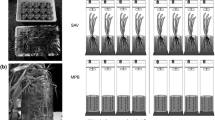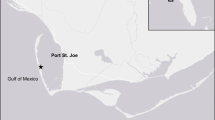Abstract
While most marine macrophytes preferentially assimilate ammonium to meet growth demand for nitrogen, some also utilize nitrate and exhibit high nitrate reductase activity (NRA). Although nitrate concentrations are often low in coastal waters during the summer and sandy beaches are generally considered to be low nutrient-input habitats, we have observed elevated NRA in leaves of some eelgrass (Zostera marina L.) plants growing immediately adjacent to the shoreline. We postulated that nitrate may become available to eelgrass and macroalgae via groundwater inputs that enter the nearshore water column. To address this possibility, we investigated the availability of groundwater nitrate for the induction of NRA in the leaves of eelgrass and in the macroalgaeSargassum filipendula C. Agardh (Phaeophyceae) andEnteromorpha intestinalis L. Link (Chlorophyceae) collected adjacent to two sandy beaches in the vicinity of Woods Hole, Massachusetts, USA. Induction of NRA was determined in the laboratory for eelgrass collected from one of the beach sites and from an offshore site, Lackey's Bay, which is isolated from groundwater input. At the two beach locations, pore water nitrate concentrations were 100 to 400µM within a few meters inland from the waterline. Nitrate efflux into the nearshore water column was quite high and variable (2160±660µmol m−2 h−1) when associated with rapid percolation (37±11 1 m−2 h−1) of nitrate-enriched pore water. Turbulent wave mixing rapidly diluted the nitrate. Macroalgae and eelgrass growing adjacent to a beach with high nitrate efflux had NR activities three- to sevenfold higher than those of algae and eelgrass growing along a beach section with low nitrate efflux. NRA of eelgrass plants from Lackey's Bay and Great Harbor increased in response to low daily nitrate additions (10 to 25µM) in the laboratory, with higher nitrate additions (50 to 200µM) yielding less dramatic responses. The increase in NRA was roughly three times higher for Great Harbor than for Lackey's Bay eelgrass. It appears that groundwater input of nitrate is sufficient to induce NRA in marine macrophytes growing near some beaches, including those with turbulent wave mixing.
Similar content being viewed by others
Literature cited
Asmus, R. (1986). Nutrient flux in short-term enclosures of intertidal sand communities. Ophelia 26: 1–18
Bokuniewicz, H. (1980). Groundwater seepage into Great South Bay, New York. Estuar. cstl mar. Sci. 10: 437–444
Bolter, M., Meyer-Reil, L.-A., Dawson, R., Liebezeit, G., Wolter, K., Szwerinski, H. (1981). Structure analysis of shallow water ecosystems: interaction of microbiological, chemical and physical characteristics measured in the overlying waters of sandy beach sediments. Estuar. coast. Shelf. Sci. 13: 579–589
Capone, D.G., Bautista, M.F. (1985). A groundwater source of nitrate in nearshore marine sediments. Nature, Lond. 313: 214–216
Capone, D.G., Slater, J. M. (1988). Interannual patterns of water table height and groundwater derived nitrate in nearshore sediments. EOS 69: 1080
Costa, J. E. (1988). Eelgrass (Zostera marina L.) in Buzzards Bay: Distribution, production, and historical changes in abundance. Ph. D. thesis, Boston University, Boston, Massachusetts
Davison, I. R., Andrews, M., Stewart, W. D. P. (1984). Regulation of growth inLaminaria digitata: use of in-vivo nitrate reductase activities as an indicator of nitrogen limitation in field populations ofLaminaria spp. Mar. Biol. 84: 207–217
Davison, I.R., Stewart, W. D. P. (1984). Studies on nitrate reductase activity inLaminaria digitata (Huds.) Lamour. I. Longitudinal and transverse profiles of nitrate reductase activity within the thallus. J. exp. mar. Biol. Ecol. 74: 201–210
D'Elia, C.F., Webb, K. L., Porter, J. W. (1981). Nitrate-rich groundwater inputs to Discovery Bay, Jamaica: a significant source of N to local coral reefs? Bull. mar. Sci. 31: 903–910
Fitzgerald, W. J., Jr (1978). Environmental parameters influencing the growth ofEnteromorpha clathrata (Roth) J. Ag. in the intertidal zone on Guam. Botanica mar. 21: 207–220
Florek, R. J., Rowe, G. T. (1983). Oxygen consumption and dissolved inorganic nutrient production in marine coastal and shelf sediments of the Middle Atlantic Bight. Int. Rev ges. Hydrobiol. 68: 73–112
Fonseca, M. S., Fisher, J. S., Zieman, J. C., Thayer, G. W. (1982). Influence of the seagrass,Zostera marina L., on current flow. Estuar. cstl Shelf Sci. 15: 351–364
Giblin, A. E., Teal, J. M., Gaines, A. G. (1983). A nitrogen budget for Town cove. In: Teal, J. M. (ed.) The coastal impact of groundwater discharge: an assessment of anthropogenic nitrogen loading in Town Cove, Orleans, MA. Final report to the Town of Orleans, Woods Hole Oceanographic Institution, Woods Hole, p. 143–159
Guerrero, M. G., Vega, J. M., Losada, M. (1981). The assimilatory nitrate-reducing system and its regulation. A. Rev. Pl. Physiol. 32: 169–204
Iizumi, H., Hattori, A. (1982). Growth and organic production of eelgrass (Zostera marina L.) in temperate waters of the Pacific coast of Japan. III. The kinetics of nitrogen uptake. Aquat. Bot. 12: 245–256
Johannes, R. E. (1980). The ecological significance of the submarine discharge of groundwater. Mar. Ecol. Prog. Ser. 3: 365–373
Kaspar, H.F. (1983). Denitrification, nitrate reduction to ammonium, and inorganic nitrogen pools in intertidal sediments. Mar. Biol. 74: 133–139
Kaspar, H. F., Asher, R. A., Boyer, I. C. (1985). Microbial nitrogen transformations in sediments and inorganic nitrogen fluxes across the sediment/water interface on the South Island west coast, New Zealand. Estuar. coast. Shelf Sci. 21: 245–255
Kenworthy, J. W., Zieman, J.C., Thayer, G. W. (1982). Evidence for the influence of seagrasses on the benthic nitrogen cycle in a coastal plain estuary near Beaufort, North Carolina (USA). Oecologia 54: 152–158
Koop, K., Newell, R. C., Lucas, M. I. (1982). Microbial regeneration of nutrients from the decomposition of macrophyte debris on the shore. Mar. Ecol. Prog. Ser. 9: 91–96
Lawrence, J. M., Herrick, H. E. (1982). Media for in vivo nitrate reductase assay of plant tissues. Pl. Sci. Lett. 24: 17–26
Lee, V., Olsen, S. (1985). Eutrophication and management initiatives for the control of nutrient inputs to Rhode Island coastal lagoons. Estuaries 8: 191–202
Lewis, J. B. (1987). Measurements of groundwater seepage flux onto a coral reef: spatial and temporal variations. Limnol. Oceanogr. 32: 1165–1169
McLachlan, A. (1982). A model for the estimation of water filtration and nutrient regeneration by exposed sandy beaches. Mar. envir. Res. 6: 37–47
McLachlan, A., McGwynne, L. (1986). Do sandy beaches accumulate nitrogen? Mar. Ecol. Prog. Ser. 34: 191–195
Murthy, M. S., Rao, A. S., Reddy, E. R. (1986) Dynamics of nitrate reductase activity in two intertidal algae under desiccation. Botanica mar. 29: 471–474
Nowicki, B. A., Nixon, S. W. (1985). Benthic nutrient remineralization in a coastal lagoon ecosystem. Estuaries 8: 182–190
Orth, R. J., Moore, K. A. (1983). Chesapeake Bay: an unprecedented decline in submerged aquatic vegetation. Science, N.Y. 222: 51–52
Persky, J. H. (1986). The relation of ground-water quality to housing density, Cape Cod, Massachusetts. U.S. Geological Survey Report 86-4093, Boston, Massachusetts
Pomroy, A. J., Joint, I. R., Clarke, K. R. (1983). Benthic nutrient flux in a shallow coastal environment. Oecologia 60: 306–312
Pregnall, A. M., Maier, C. M. (1988). Plant growth and root glutamine synthetase activity in eelgrass (Zostera marina) as affected by sediment ammonium content. EOS 69: 1115
Pregnall, A. M., Miller, S. L. (1988). Flux of ammonium from surf-zone and nearshore sediments in Nahant Bay, Massachusetts, USA in relation to free-livingPilayella littoralis. Mar. Ecol. Prog. Ser. 50: 161–167
Pregnall, A. M., Smith, R. D., Alberte, R. S. (1987). Glutamine synthetase activity and free amino acid pools of eelgrass (Zostera marina L.) roots. J. exp. mar. Biol. Ecol. 106: 211–228
Pugh, K. B., (1983). Nutrient cycles in sandy beaches. In: McLachlan, A., Erasmus, A. (eds.) Sandy beaches as ecosystems. Junk, The Hague, p. 225–233
Riedl, R. J. (1971). How much water passes through sandy beaches? Int. Rev ges. Hydrobiol. 56: 923–946
Riedl, R. J., Huang, N., Machan, R. (1972). The subtidal pump: a mechanism of interstitial water exchange by wave action. Mar. Biol. 13: 210–221
Roth, N. C., Pregnall, A. M. (1988). Nitrate reductase activity inZostera marina. Mar. Biol. 99: 457–463
Sewell, P. L. (1982). Urban groundwater as a possible nutrient source for an estuarine benthic algal bloom. Estuar. cstl Shelf Sci. 15: 569–576
Short, F. T., Mathieson, A. C., Nelson, J. I. (1986). Recurrence of the eelgrass wasting disease at the border of New Hampshire and Maine, USA. Mar. Ecol. Prog. Ser. 29: 89–92
Short, F.T., McRoy, C. P. (1984). Nitrogen uptake by leaves and roots of the seagrassZostera marina L. Botanica mar. 27: 547–555
Slater, J. M., Capone, D.G. (1987). Denitrification in aquifer soil and nearshore marine sediments influenced by groundwater nitrate. Appl. envirl Microbiol. 53: 1292–1297
Smirnoff, N., Stewart, G. R. (1985). Nitrate assimilation and translocation by higher plants: comparative physiology and ecological consequences. Physiologia Pl 64: 133–140
Solorzano, L. (1969). Determination of ammonia in natural waters by the phenol hypochlorite method. Limnol. Oceanogr. 14: 799–801
Strickland, J. D. H., Parsons, T. R. (1968). A practical handbook of seawater analysis. Bull. Fish. Res. Bd Can. 167
Thursby, G. B., Harlin, M. M. (1982). Leaf-root interaction in the uptake of ammonia byZostera marina. Mar. Biol. 72: 109–112
Thursby, G. B., Harlin, M. M. (1984). Interactions of leaves and roots ofRuppia maritima in the uptake of phosphate, ammonia and nitrate. Mar. Biol. 83: 61–67
Valiela, I. Costa, J. E. (1988). Eutrophication of Buttermilk Bay, a Cape Cod coastal embayment: concentrations of nutrients and watershed nutrient budgets. Environ. Mgmt 12: 539–551
Valiela, I., Teal, J. M., Volkmann, S., Shafer, D., Carpenter, E. J. (1978). Nutrient and particulate fluxes in a salt marsh ecosystem: tidal exchanges and inputs by precipitation and groundwater. Limnol. Oceanogr. 23: 798–812
Wheeler, W. N., Weidner, M. (1983). Effects of external inorganic nitrogen concentration on metabolism, growth and activities of key carbon and nitrogen assimilatory enzymes ofLaminaria saccharina (Phaeophyceae) in culture. J. Phycol. 19: 92–96
Zimmerman, R. C., Kremer, J. N. (1986). In situ growth and chemical composition of the giant kelp,Macrocystis pyrifera — responses to temporal changes in ambient nutrient availability. Mar. Ecol. Prog. Ser. 27: 277–285
Author information
Authors and Affiliations
Additional information
Communicated by J. Grassle, Woods Hole
Rights and permissions
About this article
Cite this article
Maier, C.M., Pregnall, A.M. Increased macrophyte nitrate reductase activity as a consequence of groundwater input of nitrate through sandy beaches. Mar. Biol. 107, 263–271 (1990). https://doi.org/10.1007/BF01319825
Accepted:
Issue Date:
DOI: https://doi.org/10.1007/BF01319825




